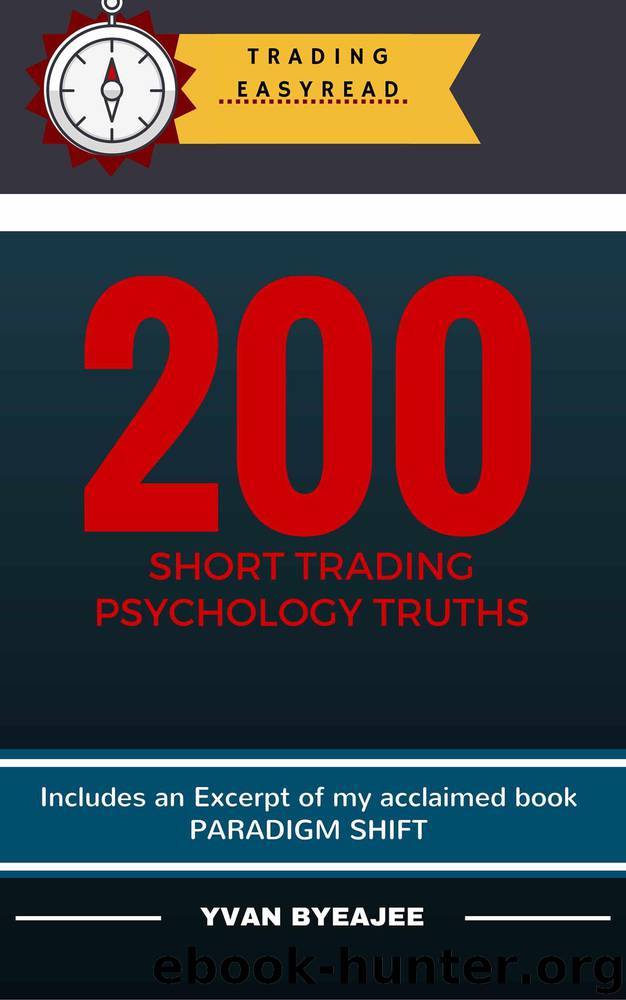200 Short Trading Psychology Truths (Trading Easyread Series Book 1) by Yvan Byeajee

Author:Yvan Byeajee [Byeajee, Yvan]
Language: eng
Format: mobi
Published: 2015-08-27T23:00:00+00:00
Unconscious incompetence
“The greatest enemy of knowledge is not ignorance; it is the illusion of knowledge.” Daniel J. Boorstin
Anyone who starts down the road to becoming a trader wants to reach consistency in their results as fast as possible but few eventually make it there. In fact, several studies suggest that most retail traders are worse off financially after the first couple of years in the financial markets than before they started trading – i.e., if they make it through those early years without going broke in the first place. This is a staggering truth and one that is echoed around most of the financial markets of the world. Naturally, this begs the question: why do so many people fail in the markets?
Retail traders are by the very definition self-employed. To succeed as a self-employed trader you need two very distinct skill-sets: first as a self-employed business owner, and second as a professional trader. Both skills work in unison, one cannot be without the other. Therefore, there is no question that for some, trading might not be a good fit at all because it requires a lot of work. Trading is a real business, though few actually treat it as such. As a matter of fact, any activity engaged on a regular basis with the intent of making money is a business. Approaching our trading operations from a business standpoint means that:
1. We have to develop a concept or an idea which aims to satisfy a market inefficiency, diversify risk and make money work for us.
2. We have to test that idea and see how it performs over time.
3. We have to hold an inventory. This is our current positions. We have to buy them for less than what we intend to sell them for.
4. We have to manage our employees. Our current positions can also be seen as our employees. We have to keep the ones that are working well, and fire the ones that aren’t.
5. We have to take insurance. Our business must have insurance to manage risk because losses will occur. It is not a matter of “if”; it is a matter of “when”. Therefore, stop-losses, hedges and position sizing are our insurance against big losses in our trading business.
6. We have to use a strategic deployment of capital. We attempt to buy things at a lower price than what we intend to sell them at. We also try to diversify what we buy so that our risks are uncorrelated and dispersed.
7. We have to conduct our business where there are ample buyers and sellers so that we don’t get stuck with positions (inventories) that no one wants.
8. We have to actively preserve our capital. If we lose that, we are out of business. Therefore, we have to make sure that we do not go “all in” on any perceived opportunity.
9. We have to work towards the expansion of our business. This can only happen after it becomes profitable. For a trading business, this translates into trading more
Download
This site does not store any files on its server. We only index and link to content provided by other sites. Please contact the content providers to delete copyright contents if any and email us, we'll remove relevant links or contents immediately.
The Brazilian Economy since the Great Financial Crisis of 20072008 by Philip Arestis Carolina Troncoso Baltar & Daniela Magalhães Prates(106438)
International Integration of the Brazilian Economy by Elias C. Grivoyannis(76127)
The Art of Coaching by Elena Aguilar(52220)
Flexible Working by Dale Gemma;(23213)
How to Stop Living Paycheck to Paycheck by Avery Breyer(19573)
The Acquirer's Multiple: How the Billionaire Contrarians of Deep Value Beat the Market by Tobias Carlisle(12119)
Thinking, Fast and Slow by Kahneman Daniel(11824)
The Radium Girls by Kate Moore(11642)
The Art of Thinking Clearly by Rolf Dobelli(9942)
Hit Refresh by Satya Nadella(8873)
The Compound Effect by Darren Hardy(8533)
Atomic Habits: Tiny Changes, Remarkable Results by James Clear(8058)
Tools of Titans by Timothy Ferriss(7834)
Turbulence by E. J. Noyes(7720)
Change Your Questions, Change Your Life by Marilee Adams(7394)
A Court of Wings and Ruin by Sarah J. Maas(7292)
Nudge - Improving Decisions about Health, Wealth, and Happiness by Thaler Sunstein(7264)
How to Be a Bawse: A Guide to Conquering Life by Lilly Singh(7167)
Win Bigly by Scott Adams(6840)
